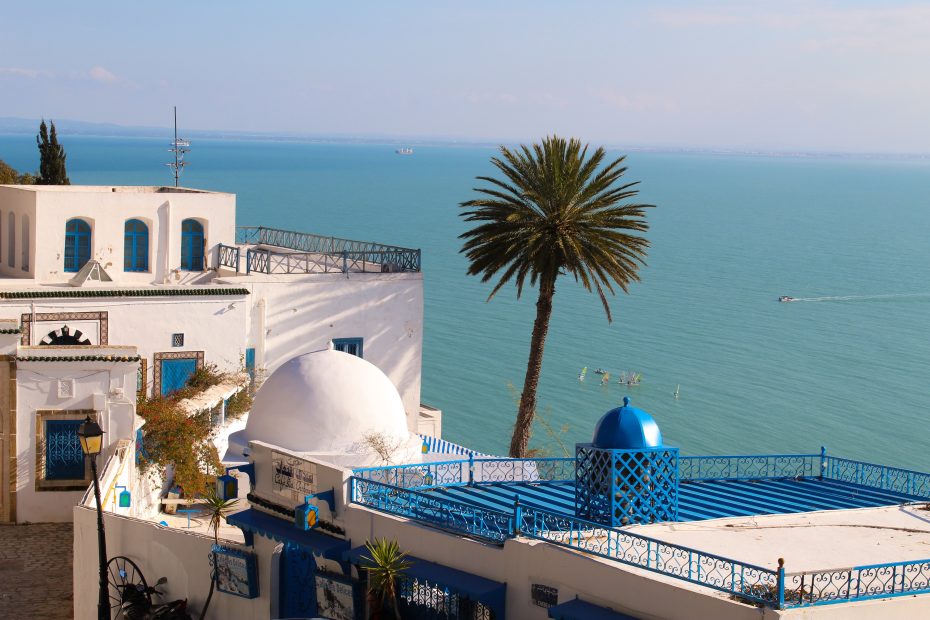Table of Contents
Introduction
Nestled along the glittering Tunisian coast, the delightful village of Sidi Bou Said stands as a veritable gem. With its lovely whitewashed houses accented with vibrant blue shutters and overflowing bougainvillea, this charming locale encapsulates a magical Old World ambience. From its cobbled lanes and distinctive architecture to its bustling cafés and stunning vistas, Sidi Bou Said remains an enchanting destination that dazzles all who visit.
Architecture and Design
The delightful beauty of Sidi Bou Said stems largely from its exquisite architecture and design. Many of the whitewashed homes and buildings reflect Andalusian influences, with their arched windows, inner courtyards, and decorative tilework. Intricate carved woodwork and door knockers add to the visual appeal. Wrought iron balcony railings, charming arches, and vaulted passageways evoke old Moorish and Ottoman architectural styles. The French imprint can also be seen, since Sidi Bou Said was once a popular haunt for French artists. Throughout the village, lovely decorative doorways and windows painted vivid shades of blue provide dazzling pops of color against the blinding white structures.
Café Culture
Beyond the architecture, Sidi Bou Said is known for its lively café culture. Visitors can while away the hours people-watching from one of the many cozy cafés and restaurants dotting the village. Savoring frothy cappuccinos, glasses of sweet mint tea, and snacks of brik pastry in the shade of a jasmine-scented patio is a favorite pastime. In the evenings, a youthful bar and club scene springs to life, where locals and tourists mingle over cocktails and shisha late into the night. The vibrant café atmosphere makes Sidi Bou Said the perfect place to relax and soak up the scene.
Stunning Coastal Views
One of Sidi Bou Said’s greatest assets is its spectacular coastal setting. Perched high on a cliff overlooking the Mediterranean Sea, the village provides breathtaking vistas around every corner. Visitors can stroll down to the waterfront promenade to admire the glittering blue waters stretching out to meet the horizon. Sunsets paint the seaside pink and gold with spectacular shows of color. Sidi Bou Said’s seaside cafés and restaurants make ideal spots for watching the boats bob in the harbor as the sun sinks below the waves. The seaside village exudes tranquility during sunny days, as residents and visitors bask in the mild climate and laidback lifestyle.
Arts Scene
In addition to its architecture and scenery, Sidi Bou Said has a thriving arts scene. Many famous painters and musicians have called this village home, inspired by its beauty and old-world atmosphere. Today, numerous art galleries, studios, and creative shops line the winding streets. An annual summer jazz festival floods the town with music and draws visitors from across the globe. In addition to visual arts and jazz, Sidi Bou Said celebrates traditional Tunisian music, crafts, and art forms. From ceramics and textiles to mosaics and calligraphy, local artisan wares beautifully convey Tunisian style and aesthetics.
Shopping Opportunities
Speaking of artisan wares, Sidi Bou Said offers fantastic shopping opportunities for tourists seeking quality souvenirs. The village is home to several souks and markets brimming with handmade goods, artwork, carpets, pottery, and other crafts. Shoppers can browse stall after stall of hand-woven textiles, embroidered tunics, glazed ceramics, and hammered metalwork. Bargaining is expected, so don’t be afraid to channel your inner haggler to get the best deals on lovely souvenirs. Beyond the markets, Sidi Bou Said’s boutiques and galleries offer a more curated selection of upscale artisan products.
Proximity to Historical Sites
An additional benefit of Sidi Bou Said is its convenient proximity to several amazing historical sites. Many visitors couple a stay in this village with day trips to the nearby ruins of ancient Carthage, El Djem’s incredible Roman amphitheater, and the seaside charm of Sousse. With so many phenomenal archaeological wonders just a short jaunt away, travelers can easily mix enchanting Sidi Bou Said with Tunisia’s fascinating history and culture. Make sure to allot an extra day or two to explore these unforgettable ancient sites near Sidi Bou Said.
Conclusion
With its postcard-perfect architecture, lively café culture, stunning coastal vistas, thriving arts scene, fabulous shopping, and convenient location, Sidi Bou Said encapsulates so much of what makes Tunisia incredible. The unbelievable beauty found around every corner leaves visitors bewitched. From its gleaming white and blue facades to its shimmering seaside setting, Sidi Bou Said is sure to enchant all who are lucky enough to experience this magical village.
FAQs
What is Sidi Bou Said known for?
Sidi Bou Said is known for its stunning whitewashed architecture accented with vibrant blue shutters, cobblestone streets, cliffside Mediterranean views, lively cafe culture, arts scene, and convenient proximity to ancient ruins.
When was Sidi Bou Said built?
Sidi Bou Said was built in the 13th century CE. First established as a religious site, it grew into a village by the 18th century. Its layout today reflects early Moorish urban planning.
What styles influenced Sidi Bou Said’s architecture?
Sidi Bou Said’s architecture reflects a blend of Andalusian, Ottoman, and French influences, seen in its arches, tilework, wrought iron accents, carved woodwork, and blue decorative elements.
What are some things to do in Sidi Bou Said?
Top activities in Sidi Bou Said include strolling the cobblestone streets, sipping coffee and mint tea at a cafe, admiring the coastal views, browsing the local souks, visiting art galleries, catching sunset by the Mediterranean, and enjoying the nightlife.
What is the best time of year to visit Sidi Bou Said?
The best time to visit Sidi Bou Said is in spring or fall, when the weather is mild and comfortable. Summers can be hot while winter tends to be wet and chilly. Spring and fall avoid the crowds and extremes of both seasons.
